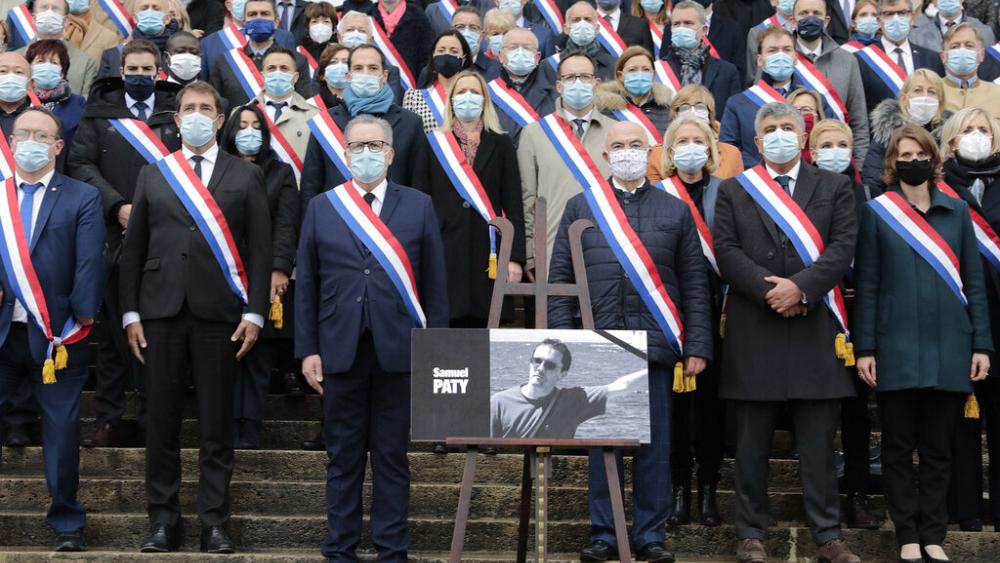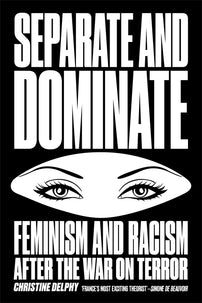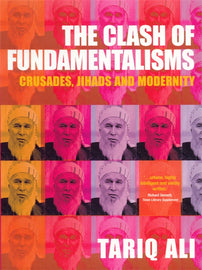A Long Republican Winter
Alain Brossat on how the reaction to the murder of Samuel Paty exposes the divisions and inequalities at the heart of the French Republicanism, and how the violence is doomed to repeat itself.

We could start with something like Wittgenstein’s dictum: if there is nothing to be said about a subject, then it’s useless to speak. Indeed, considering that no one suspects you of thinking that beheading a teacher leaving his school could be something on which one might have varying opinions (such as commendable or otherwise, in bad taste, not very clever, courageous, untimely, etc.), and which could therefore give rise to an open and relaxed conversation – any statement you might make about the event in question, beginning with an accumulation of adjectives and superlatives of repudiation and anathema, would only have the effect of placing you in the frame of a moral correctness that is the cement of all unions sacrées and assigning you your place in the herd.
So let us rather start by saying that, as far as the act of the killer or the killer himself is concerned, it is better to begin by saying nothing rather than participate in the contest of adjectives and superlatives, which is worth nothing more than any other spitting contest, and whose sole object, at the end of the day, is to proclaim oneself unconditionally republican – in a context where, on the contrary, what matters above all from the point of view of thought, politics and morality is to cast off moorings and not be republican at all, in the sense that the pack and those who inspire it have made of the term.
To talk about the topic of the day one should therefore begin by keeping quiet, or at least avoid speaking like a sleepwalker, an automaton who says such useless, vulgar and low things, to put it mildly, such governmental, media-orientated, and stupid things, in short, as that violence against persons and the shedding of blood inspires horror in all circumstances. This preliminary suspension is the condition for starting to articulate something about the case that has a chance of making sense.
But that is exactly the opposite of what most of our friends or supposed friends did, when they began by scrupulously paying obeisance to the republican rite before coming to what they really wanted to say, unaware that the rite here is not a pure form, but on the contrary, something that marks out a space, a regime of speech, and irrevocably inscribes you in it – once you start talking about ‘the thing’ under this sign, you don’t escape from it anymore. You are a republican – a republican with a conscience. The pack and its leaders love that – it keeps the show going.
So, it was only when the dust had settled a bit that it became possible to start saying something real and not just turning the prayer wheels. Saying something that has some chance of escaping insignificance in this configuration supposes, as a basic condition, starting from the beginning and sticking to this beginning, contrary to the great discursive operation which consists in evading it, making it nebulous, disguising it, transfiguring it – falsifying it to ensure the poisonous close-up on the horror scene, the moment of gore.
In the beginning, then, there is a teacher who, in a kind of civics class (whatever you call it, it’s always the same thing in different packaging), shows pictures to thirteen-year-olds. The subject of the lesson is freedom of expression, a theme that has been promoted by those in power since the attack on the premises of Charlie Hebdo. In the early days of the Republic, civic education was patriotic and revanchist, also conveying a whole moral catechism. Today it is civic-minded and its mantra is freedom of expression – which serves to draw a dividing line between the indigenous French moral and cultural world and that of a plebeian fifth column with variable contours suspected of being allergic and resistant to the ‘values of the Republic’.
In order to furnish, complete and illustrate his lecture, the teacher exhibits two supposedly satirical drawings from Charlie Hebdo, a close-up intended to implant in the soft dough of these young brains entrusted to his culture and care this primary notion: that freedom of expression, in general and in particular, is about Charlie Hebdo first and foremost, or conversely, that Charlie Hebdo is the alpha and omega, the test of tests, of freedom of expression. This obsession is a strange idée fixe. Are there not in our beautiful country, the land of human rights that are so badly abused today, other subjects, other examples on which the worthwhile theme of freedom of expression (as the beating heart of democratic life) could be usefully and pedagogically deployed? For example, the possibility for inmates of our prisons to express opinions audible outside their penal spaces, opinions concerning their condition as prisoners and other subjects of public interest as well – to give one example among a thousand?
But no, the teacher, formatted like so many of his colleagues by instructions from above, has a predilection for Charlie Hebdo – go figure why. So, he displays his two images, having mentioned that, given their somewhat provocative character (the cops who took statements no doubt have a fairly precise idea of his exact words, but we are far from knowing them) some students might be reluctant to look at them directly. Again, go figure why.
We are entitled to question here the pedagogic meaning or quality of the act of showing pictures to a class while indicating that those who do not want to see them can look away. Isn’t this the very act mentioned above, thinly disguised in a liberal attitude (feel free to look or not to look...), which amounts to drawing a dividing line between those truly included in the field of republican spirit (its values, its rites, its images) and the reluctant, refractory ones who resist republican images and are accordingly material for suspicion?
You can look away and refuse to see these images. But everyone will have understood that what you don’t want to look in the face is the Republic, and that this looking away is an early breach of the republican discipline that the school is meant to inculcate in you. By refusing to look at these images, which contain the quintessence of the republican spirit and the value attached to it, you are assigning yourself your place on the margin, in a contentious position.
But the images themselves, what do they say, what do they show, what do they bring into play?
We are not very smart, that’s a well-known fact, but not to the point of falling into the trap of simply reproducing these images as an ‘illustration’ of the point in question, and, in so doing, repeating the outrage they knowingly and treacherously inflict on those they aim to humiliate. We’re not going to show anything at all, that’s a poisoned chalice, but at least we have to talk about it, since the images are there, displayed at the heart of the matter. So our only remaining recourse is to describe them as meticulously as possible, guided by the expert hand of Foucault analysing ‘Las Meninas’ at the beginning of Words and Things or of Daniel Arasse in his magnificent analysis of the painting. But, here, the exercise is more modest and less pleasurable – being a question of dissecting and autopsying documents of barbarism.
The most controversial drawing, the one from which sensitive or susceptible souls are invited to avert their eyes (once again, go figure why), depicts a squatting figure with stretched buttocks, hairy hanging testicles and dripping penis. This character is unequivocally designated as Muslim by two distinctive signs: the skullcap on his head and the beard covering his face. Hooked nose and bulging eyes which, in other times, might have indicated a different alien exposed to mockery and public vindictiveness (the stigmata are interchangeable; they circulate as the counterfeit currency of persecution in caricatures of this kind).
The posture of the prostrate figure, in all respects grotesque and distinctly obscene, is one of prayer but also, given the subject’s nakedness, an invitation to sodomy, and strongly suggests animal, even beastly, features (the individual’s oversized and vaguely clawed feet). Here, it is the subliminal that does the trick, the good old colonial unconscious (as everyone knows, there is a slumbering sodomite in every ‘good’ Muslim – see on this subject all Orientalist literature, though I shall spare readers a list in order to save both paper and reading time). The very simplified or stylised expression of the protagonist’s face, if it can be called that, is a mixture of devout stupidity and perverse bestiality – in imminent expectation of unnatural union and, of course, submission – another inexhaustible Orientalist cliché.
Last but not least, the character’s anus is covered by a large yellow star, distinctly associated here with Islam (but here too, a tiny move is enough to confirm the change of scapegoat, doesn’t the yellow star remind you of anything?), a sign that complements the joke in the caption above the drawing: ‘Muhammad: a star is born!’ No doubt, then, the nail being so heavily driven in, that the sodomite devotee is the Prophet himself. But, equally, every male Muslim is addressed, to see himself designated, mocked, despised and humiliated (because the bottom line, in the toxic game between ‘us’ and ‘you’, is still this more or less explicit cry from the heart: ‘We fuck you, you Muslim wogs and all your brood!’).
The question we will not stop asking is therefore the following: what exactly is the intrinsic pedagogical quality of this image, a mixture of deliberate and scabrous insult to a religion (a faith that happens to be that of a significant fraction of the working class in this country), cheap pornography and recurrent neo-colonial stereotypes? What exactly is the pedagogical quality and intent of a teacher’s action in exhibiting this caricature, in no way to analyse its signs or decipher its subliminal innuendoes, but accompanying it with a blather about ‘freedom of expression’, the substance of which consists in asserting the frank insanity that the more offensive the drawing is to some viewers, vulgar in all respects and lacking any aesthetic quality, the more such ‘freedom of expression’ is validated and enhanced. If one wanted a definition of nihilism or an illustration of the nihilistic turn of today’s norms, no need to go any further – we are here at the heart of the matter. And the problem lies, among other things, in the enthusiasm with which at least part of the teaching profession has entered this nihilistic spiral. Following a period of steady defection, we have entered a time of collective self-lobotomisation.
The so-called republican normativity which tries to impose itself here, to the point of making the presentation of Charlie Hebdo’s fetid and nauseous cartoon a quintessential pedagogical gesture, and a distinctly heroic one when things go wrong, is purely and simply the resultant, the outcome, of a flight into the imaginary. In the real world, or, more soberly, in yesterday’s world, this type of drawing was immediately associated firstly with obscenity, and secondly with incitement to hatred, hate speech as we say today. The infallible sign of this flight into the imaginary, a kind of collective mental collapse or downfall, is the fact that what was associated in the past, not without reason, with the most despicable pornography and most blatant persecution is, by the effect of a discursive and normative power grab, transfigured into a manifesto in favour of freedom of expression, of Enlightenment and the values of the Republic.
It would have been easy to demonstrate that this turn or operation was actually a collective aberration. The newspapers and media of our country could easily have done so in real time if they had not been in such a hurry to follow the pipers’ footsteps: it would have been enough to go and investigate in neighbouring countries (I am not talking about Arab or Muslim countries, near or far) and ask teachers, who are established and supposedly enlightened people from different backgrounds, what they think of the pedagogical quality of this kind of ‘material’ and the act of presenting it as a document of civilisation and progress to thirteen-year-old children. The return to reality would certainly have been shattering, as it has been with the campaign in Muslim countries to boycott French products. But no: republicanism in Charlie Hebdo mode is a bubble, a watertight sphere without doors or windows, and let the foreigner, God forbid, not interfere and lecture us. Muhammad’s balls on the front page (or on an inside page – does it really make a difference?) is the beating heart of freedom of expression, the human rights of which France is the Jerusalem, and none of this should suffer the slightest objection.
Poor country, poor people – and not only, alas, at this very moment, the poor and detestable breed who reign over it.
The second cartoon offered as a manifesto for freedom of expression is a front page published after the attack on Charlie Hebdo. This represents another version of the politics of contempt, less pornographic than the previous one, but no less venomous. It shows a Muslim man identified as such by his turban, beard, clothing and moronic look (and again, perhaps the Prophet as well as any Muslim), carrying a sign proclaiming ‘I am Charlie’. The caption, above the drawing, says: ‘All is forgiven’.
What this means is completely clear: whatever you may do against us, we will remain in all respects beyond your reach, our moral quality and natural distinction (who is this subliminal ‘we’ that speaks here – each person can give their own answer) place us above the band of fanatical fools that you are. ‘You’ and ‘us’, again and again, against a backdrop of a war of civilisations (races, religions...) that is inexpiable and interminable – this is the philosophy of the present, the philosophy of the story of Charlie Hebdo and those who recognise themselves in it, reduced to its clearest and simplest expression.
In the end, therefore, idiots that you are, you will end up adopting the rallying sign of civilised humanity, ‘I am Charlie’ – and how could you do otherwise, so self-evident it is. And we, the aristocracy of the mind and everything else, masters of superior irony, will then be in a position to give free rein to our limitless humourist powers. ‘All is forgiven’ – in other words, you are so stupid, so beneath us and abject that we will not waste our time hating you.
In real life, which is far removed from the front pages of Charlie Hebdo, it is rather the opposite that imposes its conditions, as the serial trial underway today shows: nothing is forgiven and a ruthless vindictiveness pursues all those reputed to have maintained links or collusion, however far removed, with the perpetrators of the attack – all of whom, it is not too risky to predict, will be condemned to elimination. But what do these small details matter? What matters is what is on the front page, something those it targets cannot misunderstand, known as the ‘blow of contempt’. This blow, variations of which proliferate in what Axel Honneth calls the ‘society of contempt’, consists here very distinctly in putting the (abject) other in his or her place and drawing with a vigorous stroke of the pen the dividing line separating us from him or her.
By displaying these cartoons in class, the arsonist teacher adds his own stroke to that dividing line, well aware that some students know they are on the other side, whether they like it or not. It is to these that he indicates, in a word where the same superior irony shines through as in the drawing, that they may, if their minds are so fogged up with superstitions sensibilities, ‘turn away for a few moments’. Old story: the superstitious, the heretics, are those who refuse to venerate images, who reject and destroy them. Which is another way of saying that these images that our spirit of boundless tolerance allows children who are deplorably foreign to the true faith (the republican faith, but here resembling the Catholic one) not to look at are holy images, and that what the teacher who presents them in class is doing is akin to the celebration of a cult. Let us not pretend it’s a new discovery that republican teachers have, as a rule, always been a kind of priests. This was pointed out long ago, and it is a poor age in which a racist rag has come to replace the little illustrated catechism of yesteryear.
In an article of irreproachable republican quality and yet abundantly perfumed with the most deserving democratic and anti-racist scruples, Pierre Tevanian gives the substance of his thought. ‘We have the right to hate this humour,’ he writes about the Charlie Hebdo cartoons, ‘we have the right to consider that some of these cartoons incite racist or sexist contempt or hatred, among other possible grievances, and we have the right to say so. It is lawful to write this down, to go and say it in court, and even on demonstrations. But – and this used to go without saying, but the attack of January 2015 forces us to state it expressly – whatever evil one may think of these drawings, of their brutality, their indelicacy, their gratuitous nastiness towards people who are often destitute, their racism at times, the symbolic violence they exert cannot be compared with the extreme physical violence of homicide, and cannot therefore provide the slightest beginning of justification for that.’
It could not be better put, in the republican catechism genre, and it could not be better stated in the clerical tone of preaching and edification. The only problem is that the conflict referred to here is not soluble by the most refined of moral lessons. The conflict, precisely in so far as it is irreducible to discursive and communicational operations, to settled procedures and the conditions laid down by political and legal normativity in the present democracies, means and will continue to mean that in certain particular circumstances the harm suffered will not be an occasion for legal proceedings (the outcome known in advance), demonstrations (banned, dispersed with tear gas and flashballs) or public debate (the media are well-organised), but rather for an explosion of violence. It is this configuration, doomed to repetition by the inaudible and irreparable nature of the harm suffered, that is here the real, the conflict being its the tangible expression – as opposed to the celestial music of homilies declaimed from the pulpit by the philosopher in cassock and surplice.
The philosopher’s job here and now is critical analysis of the present: diagnosis and, if possible, genealogy (how did we get to this point, falling so low?), not republican sermons. As long as there are moments of discursive, disciplinary, pedagogical, authoritarian and, to say the least, foolish violence in schools and other places, as heavy as the one that has just caused matters to boil over, there will be these strident returns of the boomerang, setting in motion weeping choirs that are easily perceived on close inspection to be no more than the ancient Furies in modern guise.*
This is the crucial point, not anything else. The rest is a funerary and macabre version of republican theatre, nothing of which deserves any consideration.
[book-strip index="1" style="display"]Originally published in Lundimatin, 3 November 2020, https://lundi.am/Un-long-hiver-republicain
Translated by David Fernbach
* Tevanian may well oppose ‘symbolic violence’ (inconvenient, but not so serious, bearable like a wasp sting, as long as you clench your teeth) to homicidal violence, which is forbidden par excellence. With the immunity of a good republican, he lives in his national bubble and wants to ignore everything about the distinctly and massively homicidal extension of the symbolic violence exercised by the cartoons, where bombs dropped by Coalition planes have never really differentiated between jihadist fighters and civilians, women and children included. Tevanian’s own ‘principle’ is to assume he has solved the very problem on which his moralizing pathos brings him up short.





